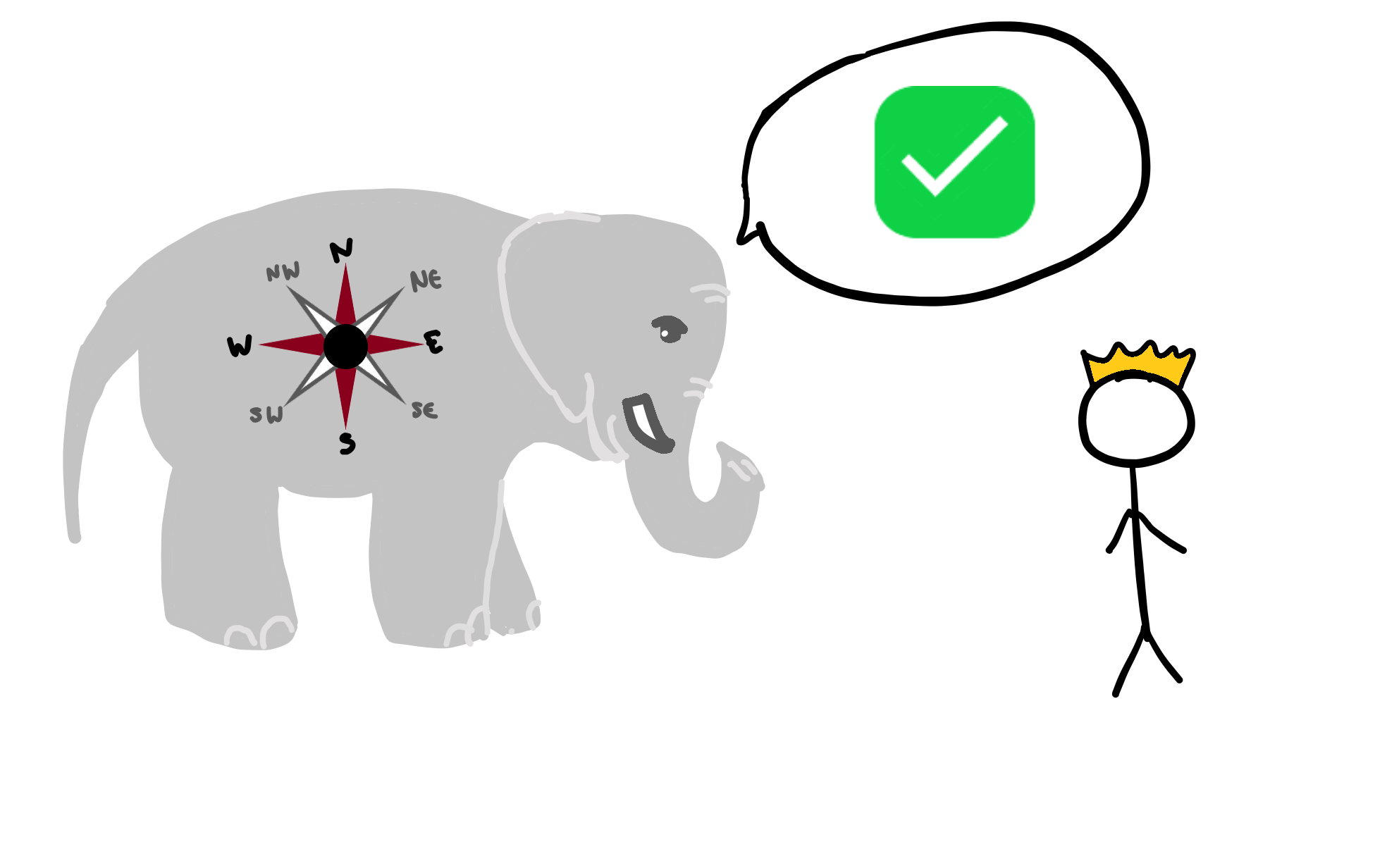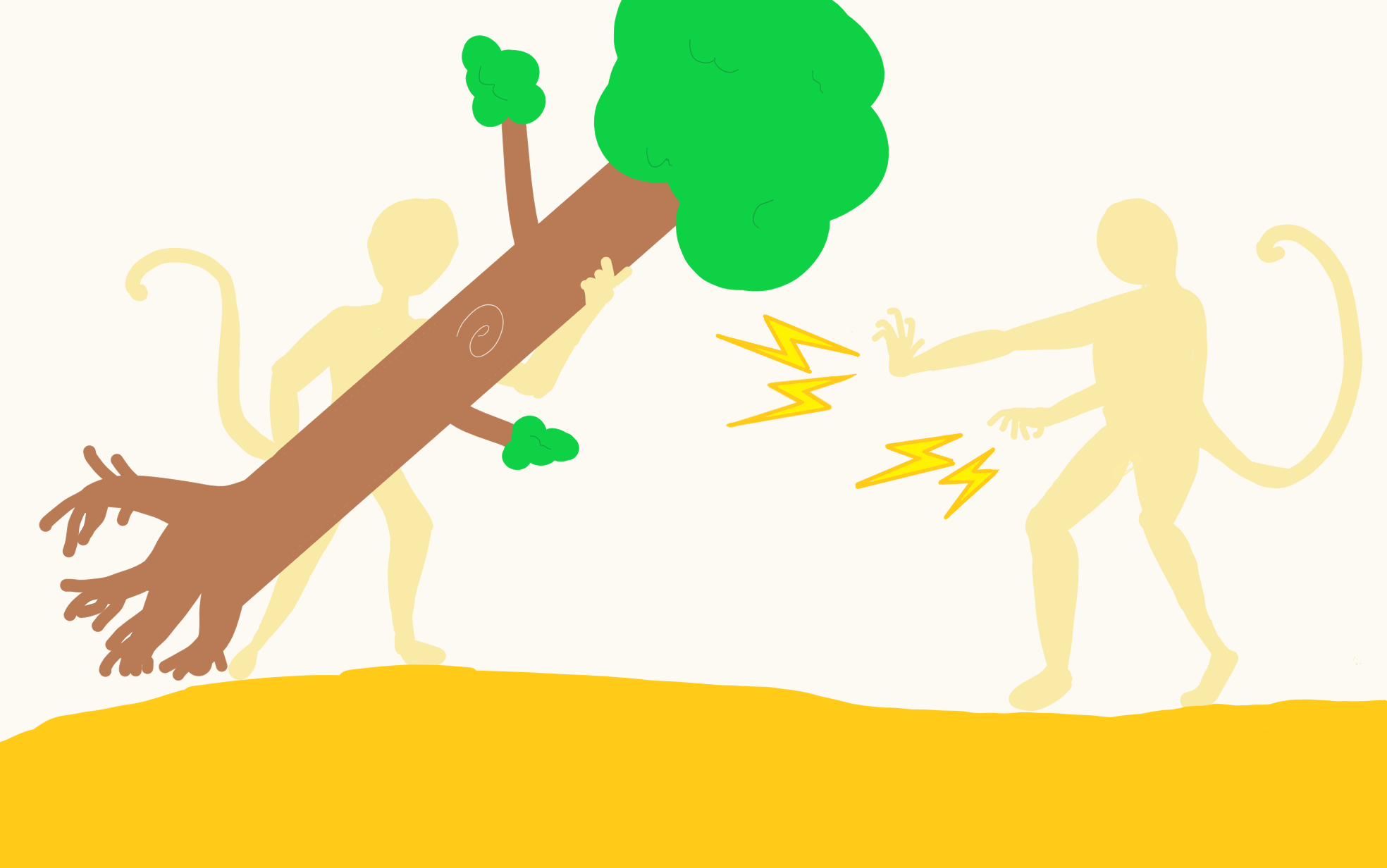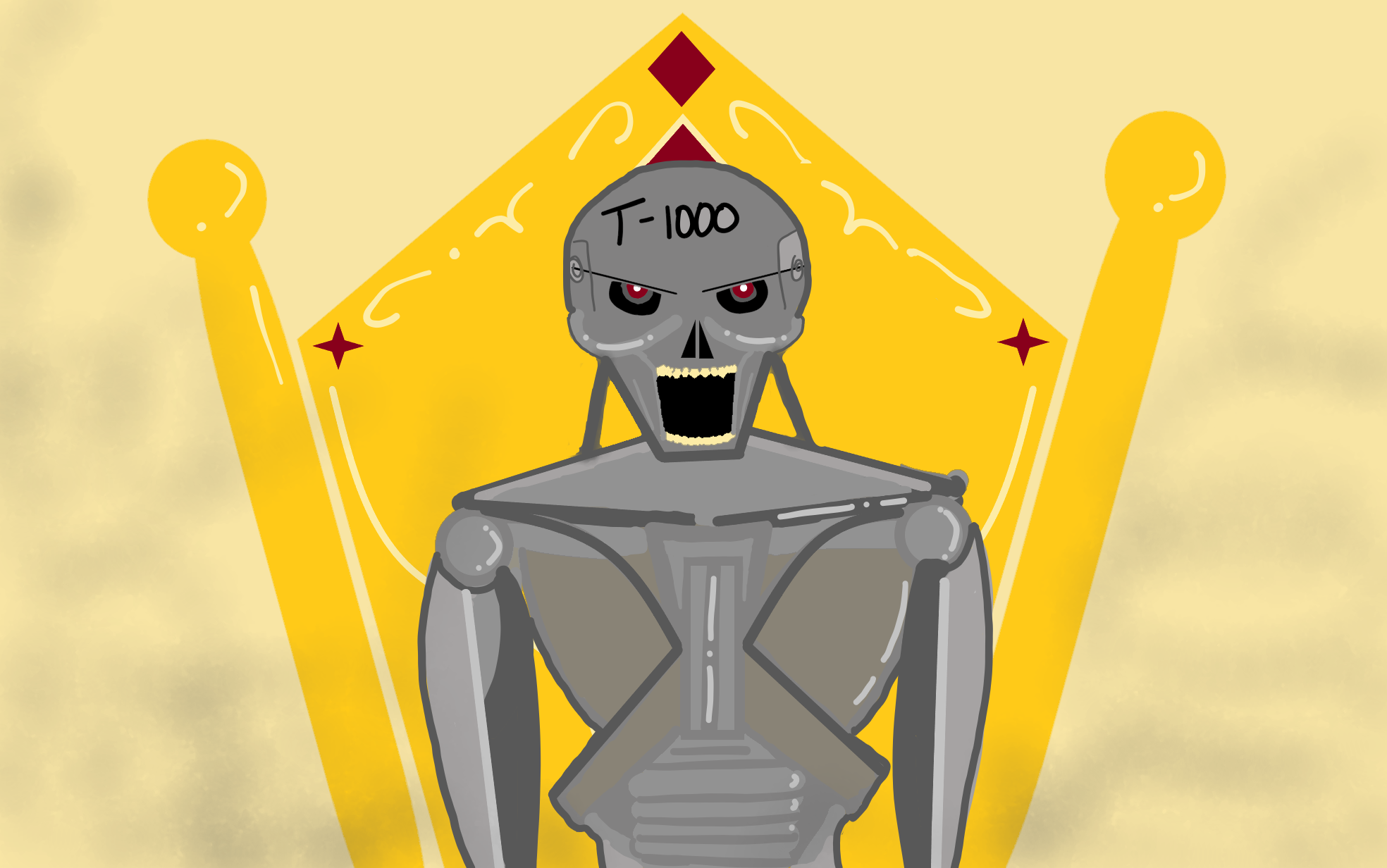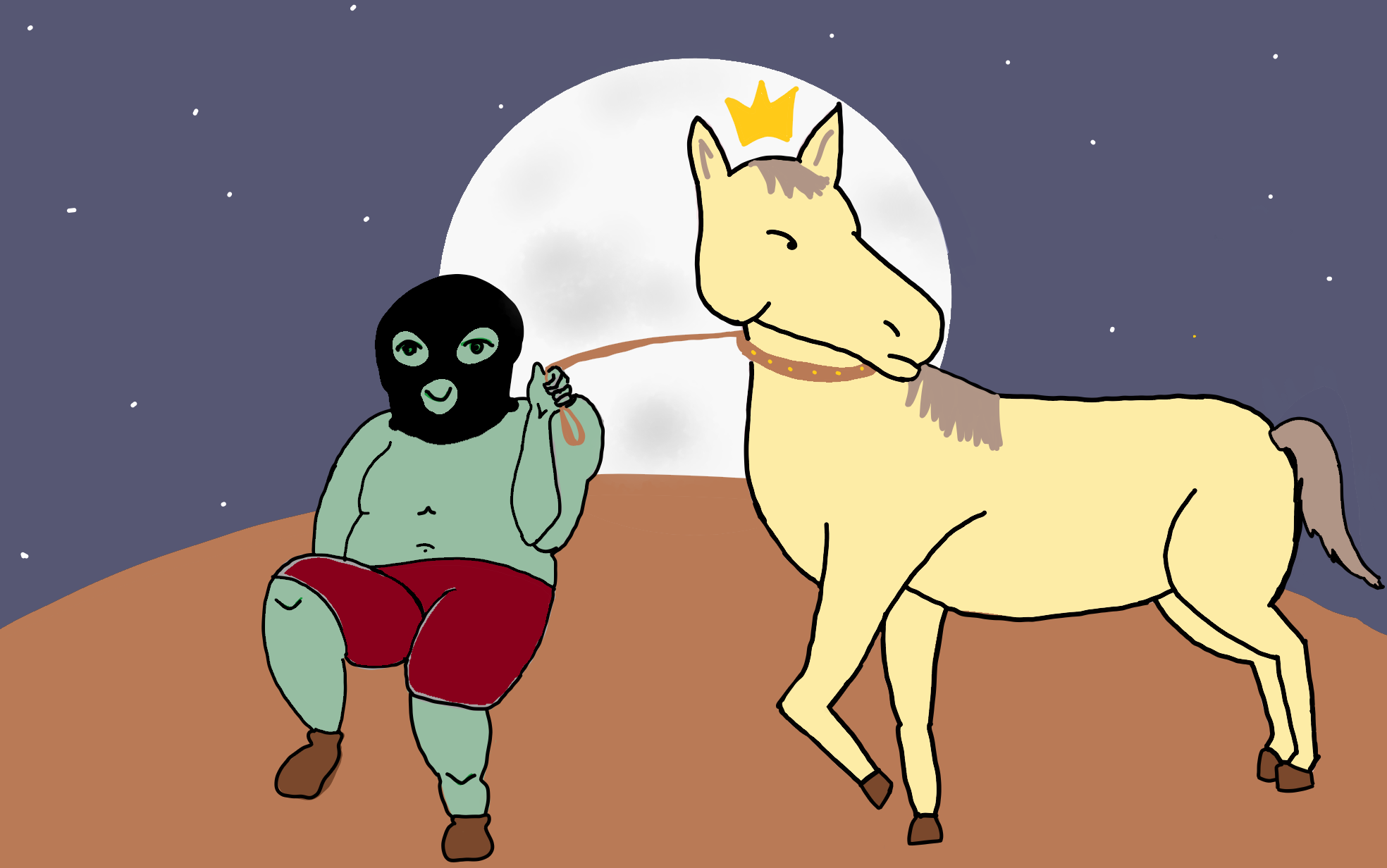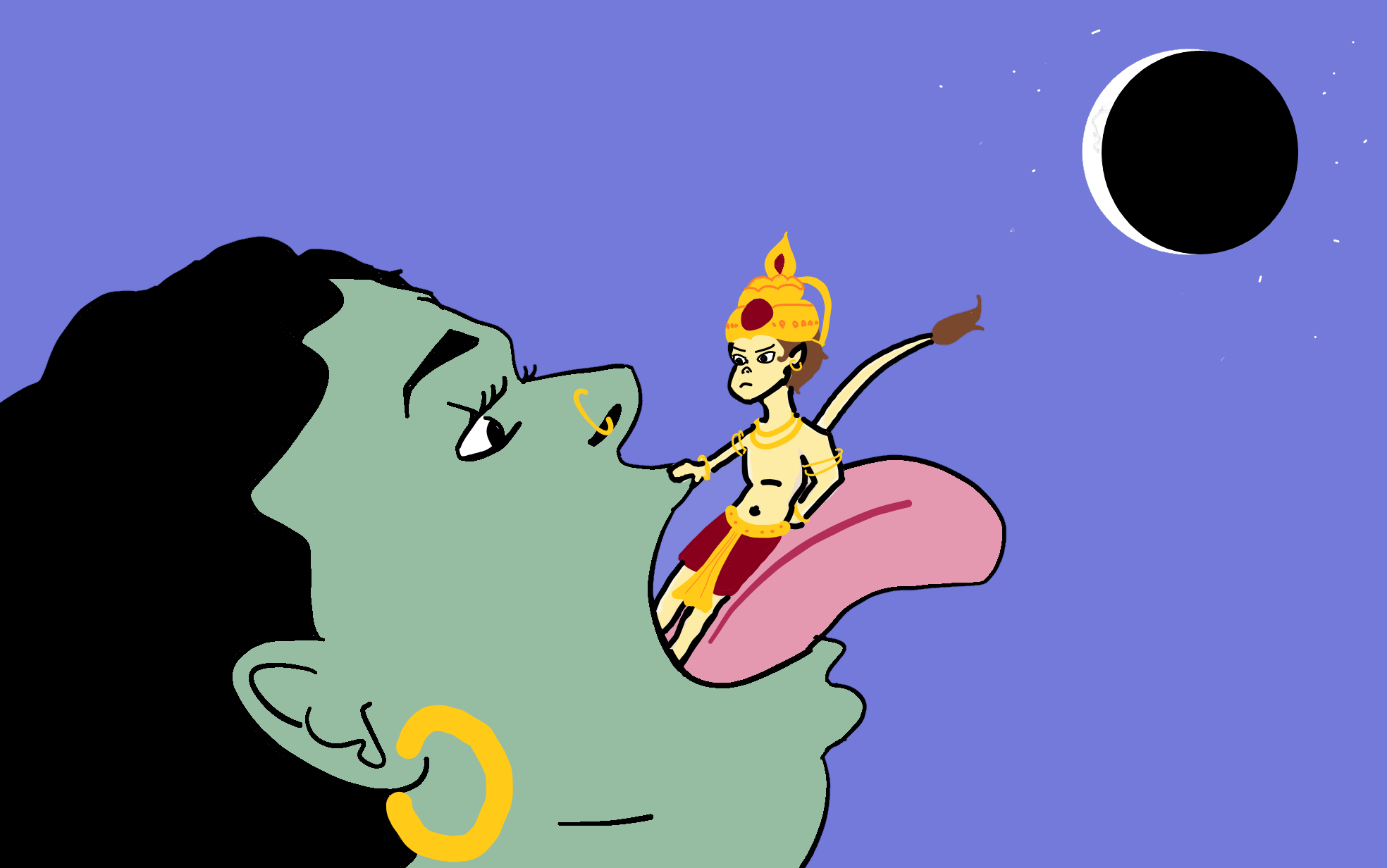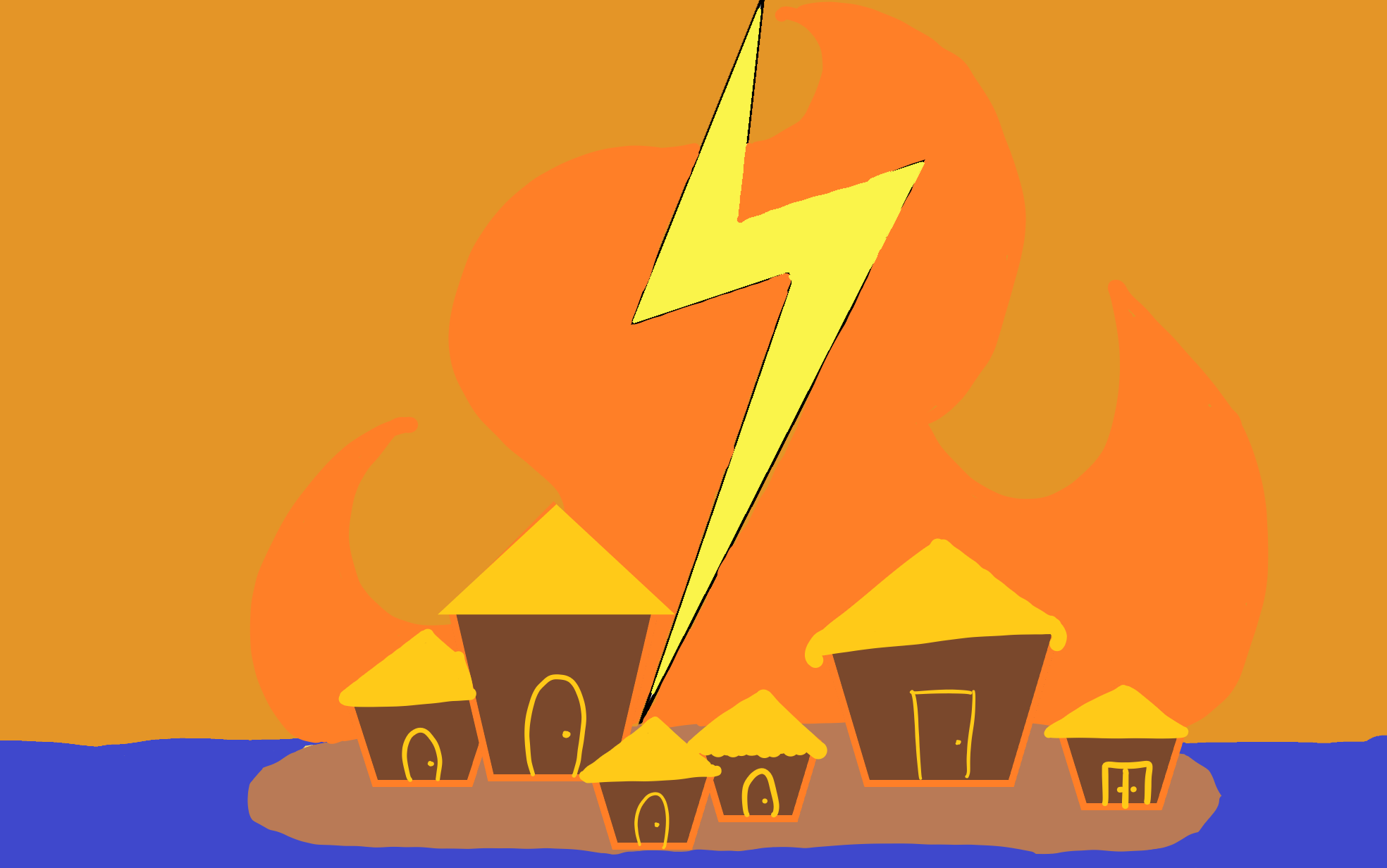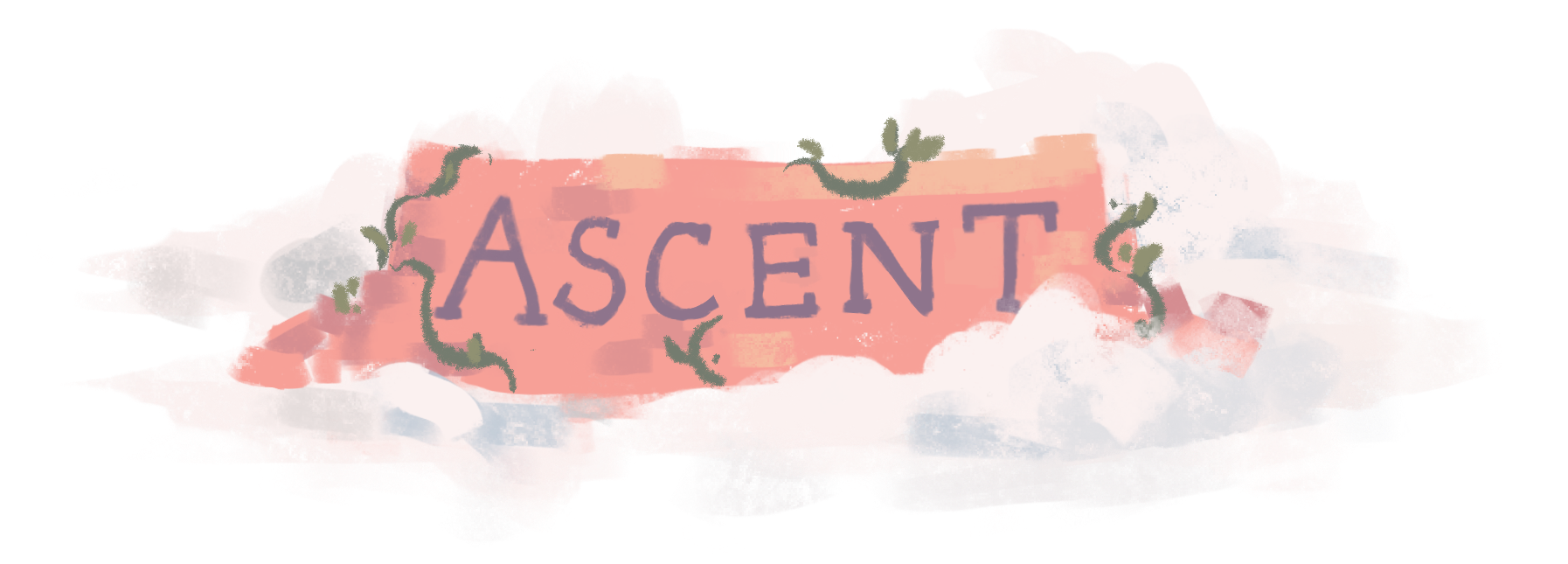To Numbers and Back Again
by Abhijit Mudigonda, Arpit Ranasaria, Nishant Pappireddi, and Sophie Mori, with art by Anusha Mudigonda
Answer: जन्तुः
This puzzle is about the classical Indian language Sanskrit. The puzzle consists of a meta followed by four minis. As clued by the global flavortext, each mini will be associated with an old scheme for converting symbols to numbers and ultimately yield six numbers. In the meta we will use these 24 numbers to recover Sanskrit sounds.
Shifting and Stepping
The puzzle is set in a complex of rooms connected in two ways: via archway and via staircase. Reading along the first letters of each sentence gives the cluephrase “GRAHA BHEDAM HALF STEP”. The first part of the cluephrase, Graha bhedam, is an operation in Carnatic (South Indian classical) music which takes a raagam (analogous to a mode in Western classical music) to another raagam by shifting the tonic. Given the overall Indian theming of the puzzle, this clues that the puzzle is based on the Melakarta raagam system of Carnatic (South Indian Classical) music. Each room in this complex corresponds to one of the 72 Melakarta raagams. The two ways of passing from room to room: via archway and via staircase - correspond to the two parts of the cluephrase, graha bhedam from the current raagam (shifting) and going to a raagam which differs from the current one by a half step (stepping). Each melakarta raagam has seven notes, so going up seven levels in the staircase takes you back to the current room. This is confirmed by the drone, which represents the tonic - it changes when going up and down levels of the staircase, but not when going between rooms via archway. Several rooms have environmental descriptors. These tell you what chakram the raagam is in:
- The hot rooms are in the Agni (fire) chakram;
- The room with a storm is in the Rudra (god of wind/storms) chakram;
- The room with arrows is in the Bana (bow) chakram;
- The moonlit room is in the Indu (moon) chakram;
- The rooms with art of the Big Dipper are in the Rishi chakram, as the Big Dipper in Sanskrit is the “seven sages”;
- The rooms with a 10 pointed “compass rose” are in the Disi (direction) chakram.
We can now go line by line. Throughout, we use the Indian solfege notation S R G M P D N S (analogous to do re mi fa so la ti do). We refer to raagams by their index in the list of Melakarta raagams - this index comes from the Katapayadi system, as the name of the raagam encodes its index in the 72 (which are ordered lexicographically). Two raagams are said to be neighbors if they differ by a half step in a single scale degree.
| Groaning, you awaken, supine, in a large chamber. | |
| Reverberating through the room is a soft droning sound, playing a single note on and on. | |
| As you get up, you realize that you had been lying on a carpet of arrows...how strange. | This tells you that the Room 1 is in the bana chakram. |
| Hidden beneath the arrows is a small green token, which you pocket. | The green token is in Room 1. |
| As you turn your head, you notice two features of the room: a staircase in the center that connects the room to higher and lower floors, and large archways on the walls that lead to similar adjacent rooms with their own staircases and arches. | |
| Bemoaning your predicament, you decide to explore the complex and walk through one of the archways. | |
| Heading into the new room, you notice that it is uncomfortably warm and seems to be getting hotter still. | Room 2 is in the Agni chakram. |
| Exiting the room through another archway, you find the next room to be similarly sweltering. | Room 3 is in the Agni chakram. |
| Dashing to escape the heat, you scrape your knee badly as you run down this room's staircase; with each level descended, you notice the drone's note - which had not changed until now - decrease in pitch each level, always by at least a half step but by a varying amount each level. | |
| Additionally, you notice that some levels don't have rooms; sometimes you descend by more than one level's worth of stairs before you see another room. | |
| Mad, you must be going mad, for you've gone down seven levels now, and you see a bloodstain -- you have returned to the room where you scraped your knee. | |
| Hustling back into the stairwell, you run down to escape, escape to any other room, but you have to descend four levels until you find another room. | Exit at the (-4)th position, so taking M to be the new tonic. The fact that this shift exists and that -1, -2, and -3 do not tells you that Room 3 is either 15 or 17 |
| As you catch your breath, you peer down the staircase and realize there's no room on the level directly below you either. | This tells you that Room 3 was 15. Therefore, Room 1 was either 26 (and Room 2 was 14) or 29 (and Room 2 was 17). Also, Room 4 is 57. |
| Looking back, you realize because of the looping nature of the staircase, this staircase really only led to three distinct levels with rooms and four levels without rooms. | More confirmation about Room 3 being 15. |
| "Figures that I'd get stuck in some weird Escher-style trap," you think to yourself. | |
| Sitting down for a moment, you take stock of your surroundings. | |
| This current room has the expected staircase and archways, but unlike the previous rooms, it also has a wicked looking spiked metal chandelier dangling from the ceiling. | Confirmation that Room 4 is 57 (it is in the Disi chakram). |
| Examining the chandelier, you notice that it has ten spikes - one straight up, one straight down, and eight others fanning to the sides, but you discern nothing about its purpose. | |
| Pausing to take a deep breath, you look back at all you've done from the beginning - across the chaos you realized you'd missed a clue, but now that you understand it, you are ready to proceed. | This is a clue to realize the acrostic - taking the first letters of every sentence thus far spells "GRAHA BEDHAM" and "HALF STEP", clues for the two main mechanics of this puzzle. |
| Walking through an archway, you suddenly feel the air begin to shift, and your ears pop as the pressure drops. | |
| Within seconds, a roaring hurricane has manifested in the room, and you find yourself buffeted by the rain and wind. | Room 5 is in the Rudra chakram, so it must be 63. |
| It seems that reaching any of the room's six archways would force you to run through the worst of the storm, so you instead run to the staircase at the center of the room. | Confirmation that Room 5 is 63. |
| Peering up the stairwell, you suspect there is a room identical to the current one seven levels above you. | |
| You decide the two rooms you glimpse in between on the staircase might be worth exploring, and, not wanting to face the storm again, trudge up the stairs. . | |
| You amuse yourself for a bit by climbing up and down levels to hear the drone change. | |
| Eventually, you exit the stairwell into a room, only to find that it is yet another room that is hot and heating up by the second, but one you have not visited before.. | Graha bhedam on 63 gives either 7 or 17. Of these, only Room 17 is in the Agni chakram so Room 6 is 17. Furthermore, this also clarifies the earlier ambiguity - since you have not seen 17, you could not have started in room 29, and thus Room 1 was 26. |
| You remain here for a little while to let yourself dry off, and then exit | |
| You are surprised to find yourself in a room that you'd already seen. | The only neighbor of 17 that you've seen is 15, so Room 7 is 15. |
| Passing through an archway, you find yourself in another room that you've already seen, and, in hopes of finding something different, walk through an archway. | The only neighbor of 15 you've seen is 14, so Room 8 is 14. |
| Once again, this room is a hot room - you really seem to be seeing a lot of these - but it is one you have not seen before, and at the center is a red token. | 14 has two neighbors in the agni chakram you haven't seen before - 13 and 16. |
| You nab it before escaping through one of the room's four (including, as usual, the one you entered from) archways. | Of these, only 13 has four archways leading out of it, so room 9 is 13. |
| After wandering from room to room aimlessly for a while, you find yourself in a staircase that connects six distinct rooms. | It's a surprising fact that the melakarta ragas have a unique orbit under graha bhedam of size six - this is the one commonly taught in Western music theory! (However, unlike Western music theory, the locrian is not allowed because it does not have the dominant). |
| You reach the level where a missing room would be and muse for a while before deciding to go back down one level and entering the room there. | The one directly before the disallowed shift is the natural minor (playing the white keys from B to B does not give a melakarta - it gives the locrian - but playing the white keys from A to A gives the natural minor). The natural minor is 20, so Room 10 is 20. |
| This room has several archways connecting it to other rooms. | |
| Stepping through one of them, you find yourself in a room with only four archways leading out of it. | The only neighbor of 20 with four neighbors is 19, so Room 11 is 19. |
| In this room, you find a yellow token, which you pick up. | |
| Walking through three more archways - the drone, as usual, unchanging - you find yourself in a room with only three archways leading out of it. | Room 14 has only three archways leading out of it and is three half-steps away from 19. |
| This room has a marvelous piece of wall art depicting what appears to be the Big Dipper in the sky. | Room 14 is in the Rishi chakram. Since it only has three neighbors, it is either 37 or 42. Of these, only 37 is reachable from 19 in three steps. It is not important what Rooms 12 and 13 are. |
| A blue token lies before the wall, and you pick up that one too. | |
| You walk through an archway to another room with the same wall art, and then through another archway to yet another such room. In this one, you find a violet token, and nab it. | The raagams reachable from 37 in two steps while staying in the Rishi chakram are 39 and 40, so Room 16 is 39 or 40. |
| You walk through an archway into a room lit by what appear to be moonbeams. | The moon beams clue that Room 17 is in the Indu chakram, and so it is either 3 (via Room 39) or 4 (via Room 40). |
| Climbing this room's staircase for a while, you find yourself in a room with the same sort of spiky chandelier you saw earlier. | Applying graha bhedam to 4 will never give something in the Disi chakram, so the room you climbed from must be 3 and the room you end up in is 55. Thus, Room 16 was 39, Room 17 was 3, and Room 18 is 55. |
| You walk through an archway because you'd glimpsed an orange token in that room, and you want to collect them all, right? | |
| To your surprise, you realize that you'd already visited this room, but somehow missed this token earlier. | The only neighbor of 55 that you have already visited is 19, so Room 19 is 19. |
| Taking stock of the tokens you found and where you found them, you decide that your work here is complete. | Red - 13, Yellow - 19, Orange - 19, Green - 26, Blue - 37, Violet - 39 |
Sorting in rainbow order, the answer to this puzzle are the numbers 13, 19, 19, 26, 37, 39.
Val’s Storyboard
The title of the puzzle, “Val’s Storyboard”, is a reference to Valmiki, the author of the Ramayana. Parts of the Ramayana can be referred to by kanda (book), sarga (chapter), and sloka (verse). Each image depicts a particular sloka of the Ramayana. Through reading the story, or possibly brute force, we can identify the slokas corresponding to the scenes. The bracketed numbers then specify which characters of these slokas to take, and by doing so each image yields a word. Each word corresponds to a number in the Bhutasamkhya system–which generally associates the name of a set with the size of the set. We refer to the examples on Wikipedia as well as this list to obtain a number for each image.
| kanda | sarga | sloka | chars. | extract | transliteration | translation | Bhutasamkhya number | |
|---|---|---|---|---|---|---|---|---|
| A | 2 | 40 | 35 | 4-6 | नयनैः | nayanaiH | (with the) eyes | 2 |
| B | 6 | 60 | 59 | 26-27 | काल | kaala | time | 3 |
| C | 1 | 41 | 9 | 25-27 | सहाश्वः | sahaashvaH | (with) horse | 7 |
| D | 4 | 16 | 28 | 33-34 | नखैः | nakhaiH | (with) nails | 20 |
| E | 3 | 32 | 6 | 1-2 | देव | deva | god | 33 |
Plugging these into the given mathematical equations, we end up with the numbers 1, 2, 3, 11, 16, 24.
Surfing Through Time and Space
We are provided with a sorted list of unix time timestamps. Taking last two digits of the timestamp and applying A1Z26, spell out the cluephrase “PARTITION DOTW THEN DRAW SEGMENTS BETWEEN NAKSHATRAS ON C SPHERE”. Every timestamp is on one of the five weekdays, and after partitioning by day of the week, there are exactly two timestamps per year. Each timestamp can be associated with a nakshatra - a lunar mansion. Roughly, the 27 nakshatras divide the orbit of the moon - which is 360 degrees - into 27 sectors, and each nakshatra lies in one of the sectors. Thus, each time can be associated with a nakshatra, and there are numerous online calculators (nakshatras are still a major part of modern Hindu astrology, and come up in most Hindu religious ceremonies) for doing so. Note that the nakshatra - which corresponds to the position of the moon relative to the stars - depends only on the absolute time - these sites ask for location only to adjust the input time for time zone. In any case, after partitioning by day of the week and finding nakshatras, we obtain the following.
| Timestamp | Datetime | Day of the week | Nakshatra |
|---|---|---|---|
| 1470682816 | 8/8/2016 19:00:16 | Monday | Chitra |
| 1475499601 | 10/3/2016 13:00:01 | Monday | Svati |
| 1499076009 | 7/3/2017 10:00:09 | Monday | Svati |
| 1500904820 | 7/24/2017 14:00:20 | Monday | Ashlesha |
| 1525705214 | 5/7/2018 15:00:14 | Monday | Shravana |
| 1546268420 | 12/31/2018 15:00:20 | Monday | Svati |
| 1549285208 | 2/4/2019 13:00:08 | Monday | Shravana |
| 1573437623 | 11/11/2019 2:00:23 | Monday | Ashvini |
| 1584950413 | 3/23/2020 8:00:13 | Monday | Purva Bhadrapada |
| 1597039214 | 8/10/2020 6:00:14 | Monday | Ashvini |
| 1632139214 | 9/20/2021 12:00:14 | Monday | Purva Bhadrapada |
| 1634587201 | 10/18/2021 20:00:01 | Monday | Uttara Bhadrapada |
| 1658174401 | 7/18/2022 20:00:01 | Monday | Uttara Bhadrapada |
| 1667804400 | 11/7/2022 7:00:00 | Monday | Ashvini |
| 1691398819 | 8/7/2023 9:00:19 | Monday | Ashvini |
| 1703476805 | 12/25/2023 4:00:05 | Monday | Rohini |
| 1475596818 | 10/4/2016 16:00:18 | Tuesday | Vishakha |
| 1480399220 | 11/29/2016 6:00:20 | Tuesday | Anuradha |
| 1503986409 | 8/29/2017 6:00:09 | Tuesday | Anuradha |
| 1506445215 | 9/26/2017 17:00:15 | Tuesday | Jyeshtha |
| 1530032400 | 6/26/2018 17:00:00 | Tuesday | Jyeshtha |
| 1534838415 | 8/21/2018 8:00:15 | Tuesday | Mula |
| 1551157205 | 2/26/2019 5:00:05 | Tuesday | Anuradha |
| 1552388414 | 3/12/2019 11:00:14 | Tuesday | Krittika |
| 1579586400 | 1/21/2020 6:00:00 | Tuesday | Jyeshtha |
| 1597132820 | 8/11/2020 8:00:20 | Tuesday | Bharani |
| 1623124805 | 6/8/2021 4:00:05 | Tuesday | Krittika |
| 1627981205 | 8/3/2021 9:00:05 | Tuesday | Rohini |
| 1641934811 | 1/11/2022 21:00:11 | Tuesday | Bharani |
| 1670346015 | 12/6/2022 17:00:15 | Tuesday | Krittika |
| 1689044400 | 7/11/2023 3:00:00 | Tuesday | Ashvini |
| 1691485216 | 8/8/2023 9:00:16 | Tuesday | Bharani |
| 1538546423 | 10/3/2018 6:00:23 | Wednesday | Punarvasu |
| 1540976400 | 10/31/2018 9:00:00 | Wednesday | Pushya |
| 1554919200 | 4/10/2019 18:00:00 | Wednesday | Mrigashirsha |
| 1562155201 | 7/3/2019 12:00:01 | Wednesday | Punarvasu |
| 1580889619 | 2/5/2020 8:00:19 | Wednesday | Mrigashirsha |
| 1602043200 | 10/7/2020 4:00:00 | Wednesday | Rohini |
| 1616000402 | 3/17/2021 17:00:02 | Wednesday | Bharani |
| 1623265220 | 6/9/2021 19:00:20 | Wednesday | Rohini |
| 1660712418 | 8/17/2022 5:00:18 | Wednesday | Ashvini |
| 1665536419 | 10/12/2022 1:00:19 | Wednesday | Bharani |
| 1694599205 | 9/13/2023 10:00:05 | Wednesday | Magha |
| 1703048418 | 12/20/2023 5:00:18 | Wednesday | Uttara Bhadrapada |
| 1596121205 | 7/30/2020 15:00:05 | Thursday | Jyeshtha |
| 1600909219 | 9/24/2020 1:00:19 | Thursday | Mula |
| 1624543223 | 6/24/2021 14:00:23 | Thursday | Mula |
| 1631793614 | 9/16/2021 12:00:14 | Thursday | Uttara Ashadha |
| 1650517219 | 4/21/2022 5:00:19 | Thursday | Mula |
| 1659027620 | 7/28/2022 17:00:20 | Thursday | Pushya |
| 1680156000 | 3/30/2023 6:00:00 | Thursday | Punarvasu |
| 1692241208 | 8/17/2023 3:00:08 | Thursday | Magha |
| 1531447204 | 7/13/2018 2:00:04 | Friday | Punarvasu |
| 1535688020 | 8/31/2018 4:00:20 | Friday | Ashvini |
| 1555084804 | 4/12/2019 16:00:04 | Friday | Punarvasu |
| 1558090818 | 5/17/2019 11:00:18 | Friday | Svati |
| 1581685205 | 2/14/2020 13:00:05 | Friday | Svati |
| 1582308007 | 2/21/2020 18:00:07 | Friday | Shravana |
| 1630051205 | 8/27/2021 8:00:05 | Friday | Ashvini |
| 1631876400 | 9/17/2021 11:00:00 | Friday | Shravana |
| 1651863608 | 5/6/2022 19:00:08 | Friday | Punarvasu |
| 1661479201 | 8/26/2022 2:00:01 | Friday | Ashlesha |
| 1678456814 | 3/10/2023 14:00:14 | Friday | Chitra |
| 1683262803 | 5/5/2023 5:00:03 | Friday | Svati |
We can now draw lines on the celestial sphere - the two nakshatras in each year give us a line segment. In what follows, the left and right disks are the Northern and Southern celestial hemispheres.
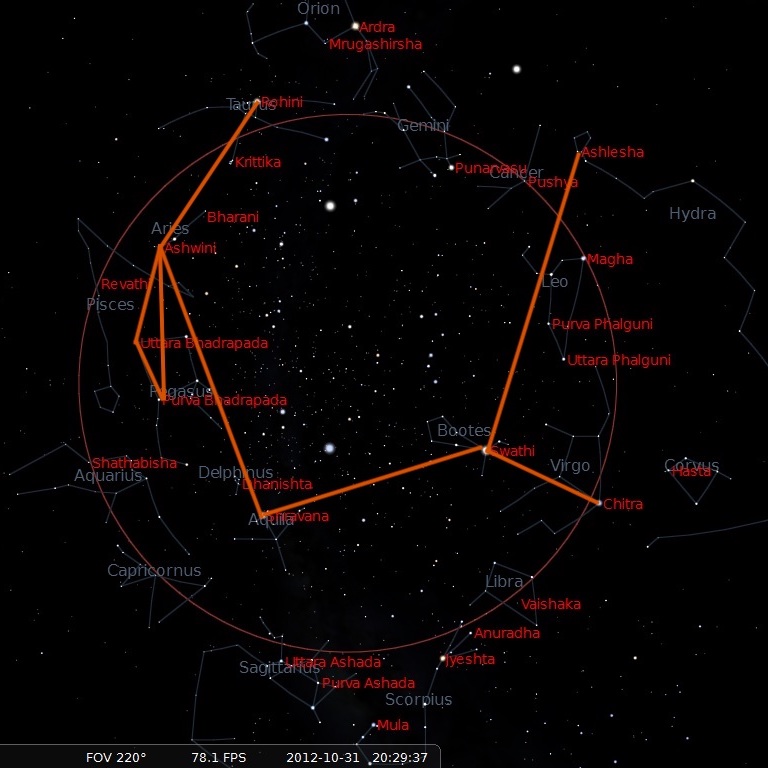
Monday
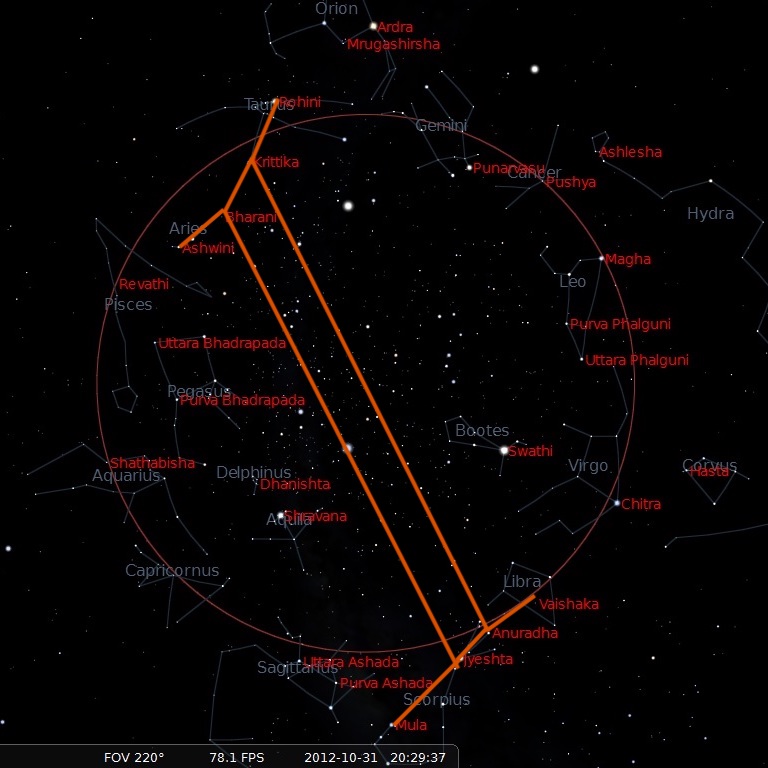
Tuesday
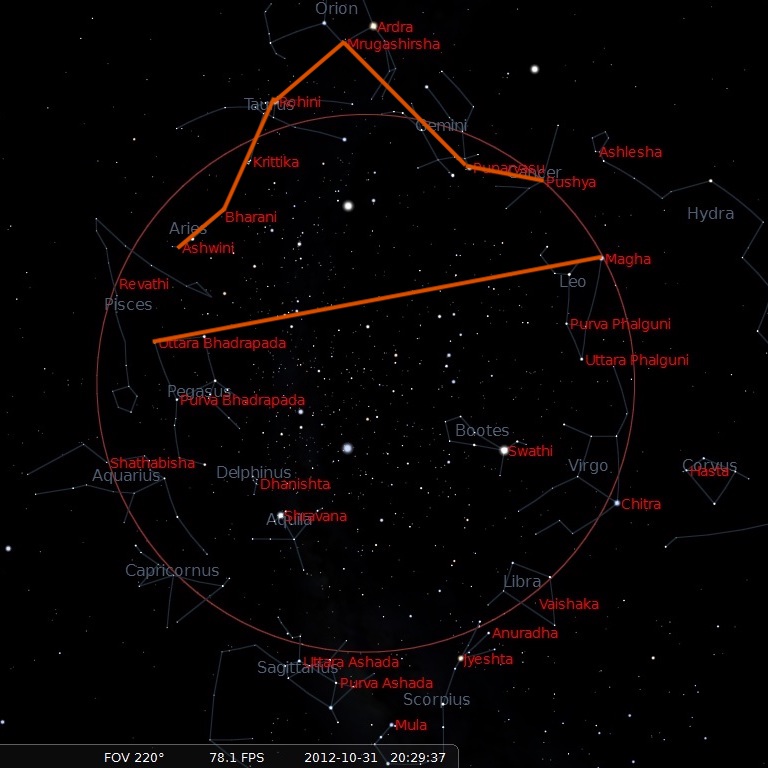
Wednesday
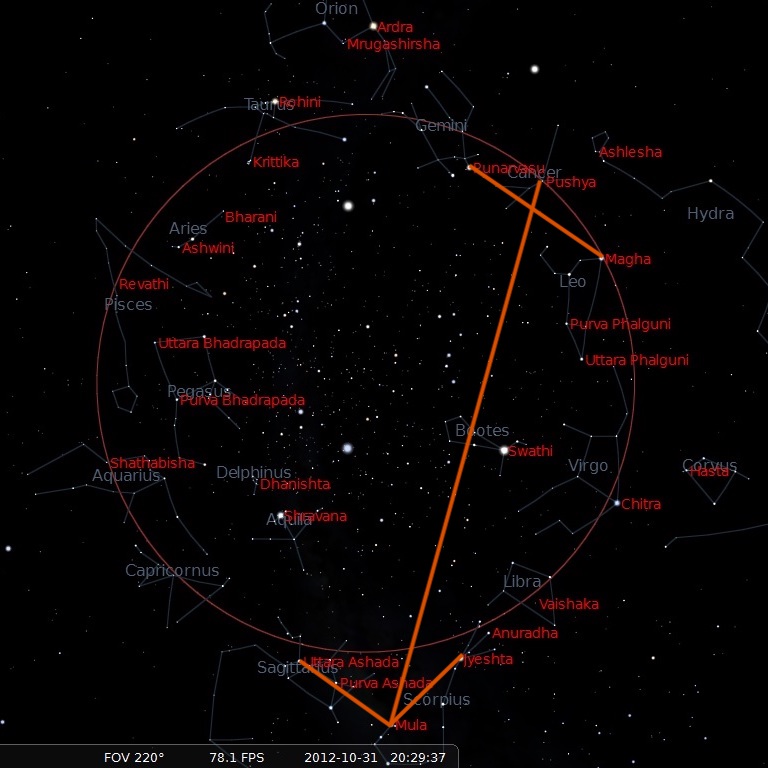
Thursday
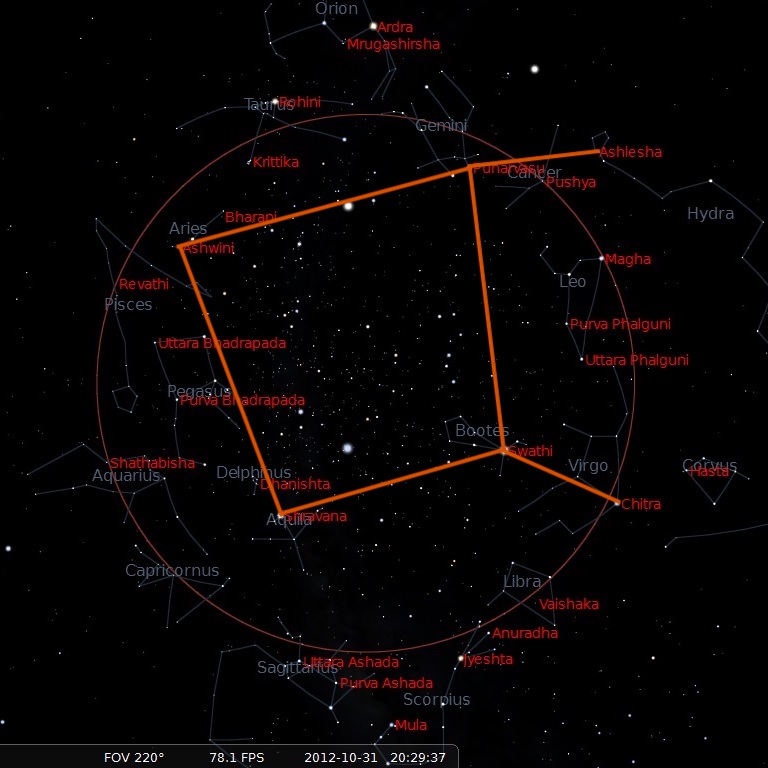
Friday
Each of these constellations is a (Western) zodiac symbol. The zodiac constellations (probably) predate both Hellenic and Vedic astronomy, and both use the same zodiac symbols. Thus, we obtain the following.
| Day of the week | Zodiac symbol | English name | Sanskrit name |
|---|---|---|---|
| Monday | ♑♑ | Capricorn | Makara (मकर) |
| Tuesday | ♊♊ | Gemini | Mithuna (मिथुन) |
| Wednesday | ♎♎ | Libra | Tulā (तुला) |
| Thursday | ♐♐ | Sagittarius | Dhanuṣa (धनुष) |
| Friday | ♉♉ | Taurus | Vṛṣabha (वृषभ) |
We now look at the six lines at the bottom of the puzzle. There are five distinct Devanagari characters which appear: सो, म, बु, बृ, शु. These are the first letters of the Sanskrit words for Monday, Tuesday, Wednesday, Thursday, and Friday, respectively.
We can apply the Aryabhata numeration scheme - which was traditionally used in astronomical texts - to associate the characters in the above constellation names with numbers.
बृ[1] (mod 123) = 19 (mod 123) = 19
म[3] म[2] शु[1] (mod 123) = 20 + 170000 + 60000000 (mod 123) = 19
सो[1] (mod 123) = 25 (mod 123) = 25
बु[2] बृ[2] शु[1] (mod 123) = 50 + 200000 + 60000000 (mod 123) = 37
शु[3] म[2] (mod 123) = 24 + 170000 (mod 123) = 38
सो[1] म[1] बु[1] (mod 123) = 25 + 2500 + 160000 (mod 123) = 42
Thus, the answer to this minipuzzle are the numbers 19, 19, 25, 37, 38, 42.
Traditional Chess Puzzles
As clued by the flavortext, these are seriesmover puzzles, where White must make two moves in a row with no reply from Black, though the first move cannot be a check. At the end of this series of moves, Black should be checkmated or otherwise defeated.
However, these puzzles are not generally solvable under regular chess rules. In addition, the boards look strange, with no checkered pattern and with X’s on some squares. Given the title of this minipuzzle and the presence of Devanagari letters, we might deduce that we are dealing with the ancient Indian variant of chess called Chaturanga.
In Chaturanga, the king, rook, and knight have the same moves as in modern chess. The pawn mostly moves the same too, though it doesn’t have an initial double-step move. There are a few possible variants of promotion rules, but here we’ll use the version where the pawn must promote to the piece originally occupying the promotion square. The queen moves one step diagonally, while the bishop moves two spaces diagonally, while being able to jump over any piece in the square in between (this is the first of the 3 potential movement rules described on Chaturanga’s Wikipedia page, and the one that is most commonly seen in other sources). We will also assume the normal check and checkmate rules, though a player can also win by baring the opponent’s king, i.e., by capturing all enemy pieces except the king.
For each of the 6 Chaturanga puzzles, we find the squares White moves into for their first and second moves. Finding the corresponding Devanagari letters or syllables on the extraction board at the end, we convert them to numbers according to the Aksharapalli scheme (which is hinted at by the page numbers). We then take the products of each pair of numbers to extract 6 numbers in ascending order: 1, 6, 16, 25, 35, 42.
| Page/Puzzle Number | White’s moves | Extracted Letters/Syllables | Aksharapalli Numbers | Product |
|---|---|---|---|---|
| 1 | e7, exf8=B# | रूं, स्व | 1, 1 | 1 |
| 2 | Qg4, Qf5# | स्ति, त्रि | 2, 3 | 6 |
| 3 | Ne6, Qxd7# | ङ्क, र्ण्क | 4, 4 | 16 |
| 4 | Bxa7, Rxc7 (bared king) | र्नृ, र्तृ | 5, 5 | 25 |
| 5 | Kb5, Ng5# | ग्र, तृ | 7, 5 | 35 |
| 6 | Kb2, Ra1# | ग्रा, घ्न | 7, 6 | 42 |
Meta
The colored rectangles in each mini title overlap with the phrase “Shiva Sutra”, which refers to Panini’s 14 aphorisms which give an ordering of Sanskrit sounds (this is disambiguated from the other Shiva Sutras by the flavor text). Note that the Shiva Sutras do not include every possible Sanskrit phoneme, only the building blocks for all phonemes. Once solvers have the numbers from all the minis, they index into the Shiva Sutras to obtain the following:
Each box is a single Sanskrit character, so sounds are collapsed in the “natural” way to form characters. There are two diacritics which appear. The first is an anusvara, which adds an “-m” to the end of a syllable. The second is a virama, which removes the inherent vowel which occurs with consonants. The long underlines correspond to long vowels. Putting everything together, we obtain the phrase
kim japan mucyate ___ janma samsāra bandhanāt.
Googling (in Sanskrit or English) yields that this is part of a famous phrase in the Vishnu Sahasranāma (see e.g.Wikipedia), a Sanskrit hymn which is also one of the most popular stotras in modern Hinduism, and that the missing word is jantuh. In Sanskrit, this is जन्तुः.
Several sources have the missing word instead as जन्तुर (jantur). The extraction image eliminates this ambiguity. We thank Siddharta Jayanti for proposing the Shiva Sutras as an ordering of Sanskrit sounds and the use of this sloka from the Visnu Sahasranāma as a cluephrase for the final answer.
Authors' Notes
Nishant: I mainly worked on the Chaturanga puzzles. It was fun thinking of puzzles that look ridiculous or even illegal under regular chess rules, but are valid with the vastly weaker queen and bishop pieces in Chaturanga. It was a bit tricky to make sure that our positions were legal, since the queens are restricted to one color of square (if we imagine the boards as being checkered), and the black queen starts on e8 rather than d8. Even worse, with the bishop’s (2, 2) move, any particular bishop can only reach 8 out of the 64 squares of the board! Since white’s and black’s bishops start on ranks of different parity, they can never capture each other, and a particular color of bishop can only be on a quarter of the board’s squares.
I originally started with mate in one puzzles, with jumbled sequences of Aksharapalli numbers labeling the ranks and files. We eventually decided it would be cleaner for the puzzles to be series mates in two, so that we could instead extract two numbers directly from the board squares.
Overall, it was really cool to learn about all these different number systems using Sanskrit letters, especially how different number systems had varying applications in different fields of knowledge and culture. In fact, I think the Ascent round was my favorite round in this hunt, because testsolving and factchecking these puzzles allowed me to learn a lot about different languages and cultures around the world.
Abhijit: My parents are Carnatic musicians, and I was named after the “missing” nakshatra Abhijit, so I am very pleased that I was able to sneak these aspects of my life into a puzzle :) My sister drew the art for the Ramayana minipuzzle on very short notice, and drew several other images that didn’t end up making it into the final version of the puzzle. Here are all of them - see if you can figure out what parts of the Ramayana they correspond to!
